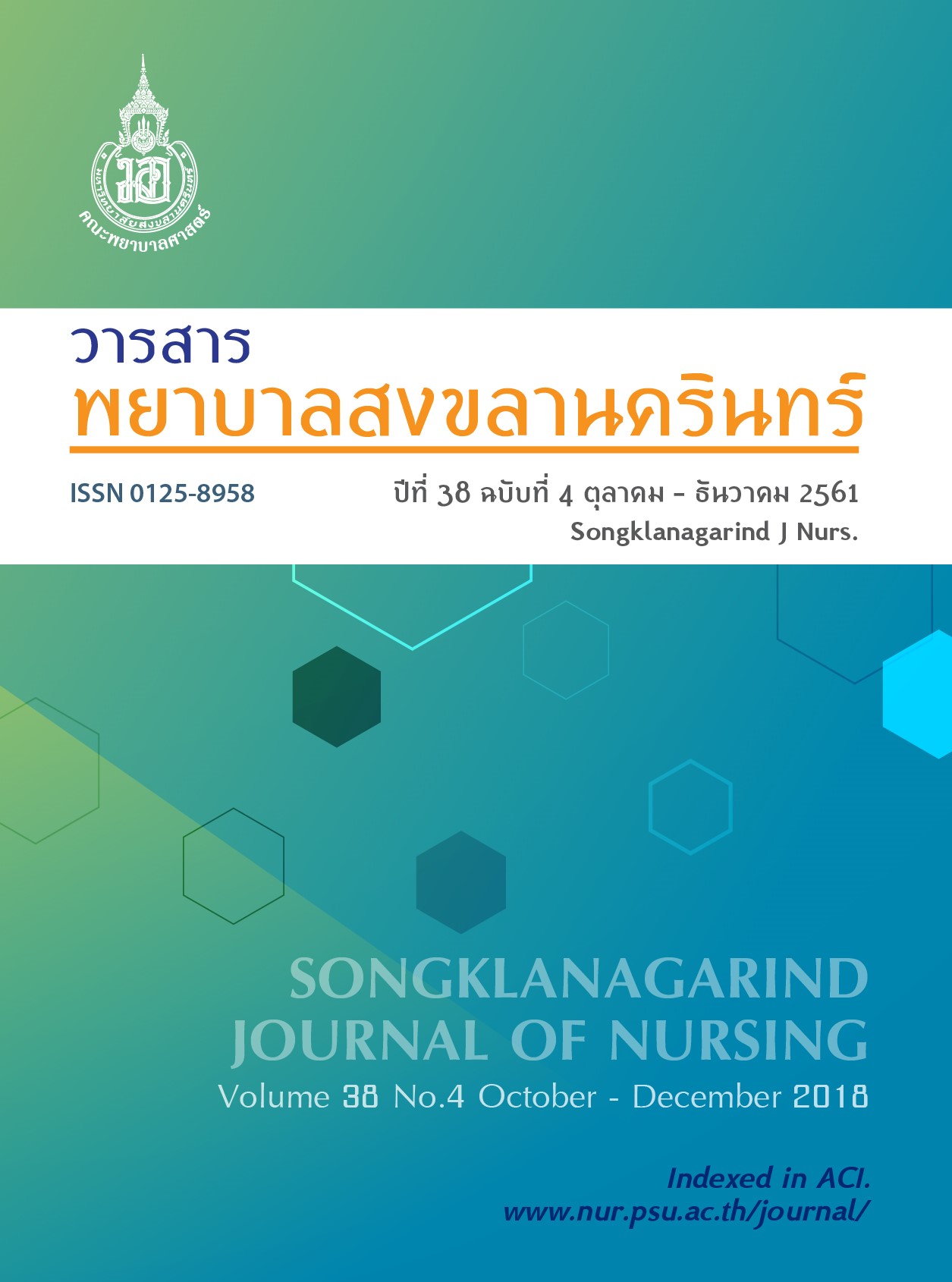Relationship Between Health Beliefs and Accessibility to Health Services for Non-Communicable Diseases Among the Five Southern Border Provinces, Thailand.
Main Article Content
Abstract
This descriptive research aimed to study the non-communicable disease situation and relationship between health beliefs and accessibility to health services of the five southern border provinces. The study comprised of two phases. Phase I is a conceptual development phase where 30 participants were purposive sampling who were administrators and health official staffs in each of the five southern border provinces. The research instruments were questionnaires developed by the researcher and the content validity was evaluated by 3 experts, with an IOC value 0.8. Data were collected in July 2017 via group discussion. The data were analyzed by using content analysis method to create the conceptual framework and questionnaire. Phase II is the survey of the non-communicable diseases situation, health beliefs, and accessibility to health services. In total 2000 samples were taken using the stratified random method. The research instruments were questionnaires developed from the conceptual framework in Phase I, with reliability 0.8. Data were collected during September to November 2017 by trained local research assistants. Data were analyzed by descriptive statistics, percentage, mean and standard deviation. Relationships among variables were tested with the statistics of the Chi-square test.
The first phase of the study found that the conceptual framework was the belief in health behavior, service of public health officials, and health services system. The second phase found that the major noncommunicable diseases were hypertension (30.0%), diabetes (9.7%), heart disease (6.00%), and cancer (0.2%) respectively. Perception of severity and risk of hypertension, diabetes, and religious beliefs correlated with accessibility to health services at the significant level of 0.05. Therefore, the public health official should raise awareness of perceived seriousness, susceptibility, cause, and impact of non-communicable diseases using cultural or traditional language and encourage participation from religious organizations.
Article Details
References
2. Bureau of non communicable diseases. Strategy and planning division. 2015; Available from: http://www.thaincd.com/2016/mission3. Thai.
3. Bureau of Non Communicable Disease. Annual Report 2017. Aksorn graphic and design publishing; 2017. Thai.
4. Awaeni S, Waram M, Saridae R, et al. Health management of people in the unrest situation in the southern border provinces. Health systems research institute; 2010. Thai.
5. Jansorn A, Bumrerraj S. Health beliefs of change model in prevention of opisthorchiasis among people in Nonghukhu sub-district, Banphue district, Udon Thani Province. Community health development quarterly Khon Kaen University. 2016; 4(3). July- September: 443-457. Thai.
6. Janz N K, Becker M H. The health belief model: A decade later. Health Education & Behavior. 1984; 11(1):1-47.
7. Praiwong C, Sattayawongtip W, Seekul P. The study of health beliefs and self-care behaviors of Patients with hypertension in Sung Noen district, Nakhon Ratchasima Province. Journal of Nakhon Ratchasima colledge. 2017; 11(1): 26-36. Thai.
8. Champion V L, Skinner C S. The health belief model. health behaviour and health education; theory, research, and practice. Jossey-Bass, San Francisco.2008; 45-65.
9. Official statistics registration system. Available from http://stat.bora.dopa.go.th/stat/pk/pk_56.pdf. Data 31 December; 2013.Thai.
10. Thanwong T, Pensirinapa N, Kirapong P. Factors related to medical care usage of chronic disease patients at sub-district health promoting hospitals in Khao Yoi Health Network, Petchaburi Province. Journal of Safety and Health. 2016; 9(31): 26-36. Thai.
11. Sutheravut P. Crisis health system,3 Southern Border Provinces. Available from: https://www.gotoknow.org/posts/4396. Thai.
12. Krejcie R V, Morgan D W. Determining sample size for research activities. Educational and psychological measurement. 1970; 30(3): 607-610.
13. Tongdee J, Rongmuang D, Nakchatree C. Health status and quality of life among the elderly in the Southern Border Provinces of Thailand. Nursing journal of the ministry of public health. 2012; 22(3): 88-99. Thai.
14. Ministry of Public Health. Summary of the results of the state inspection and supervision. Available from: http://healthdata.moph.go.th/; 2017. Thai.
15. Waiyawanjit S, Makeng M, Chintara N. The way of life of the Muslim people that affects the health promotion through adequate physical activity. Research report. Physical activity research center; 2013. Thai.
16. Chareanphan T, Surinya T. Health belief, self efficacy, parenting styles and self care behavior of the high school students at Satri Nonthaburi in Nonthaburi Province. Journal of Social science and Health. 2014; 40(1): 69-84. Thai.
17. Reginal health 12. Ministry of Public Health. Available from: http://info.sasuk12.com/archives/nitate/index.html. Thai.
18. Leangpunsakul S, Lilahkul N, Sornbut J, et al. Situation and factors affecting the success of maternal and child health in 3 Southern Provinces. Health systems research institute; 2015. Thai.

